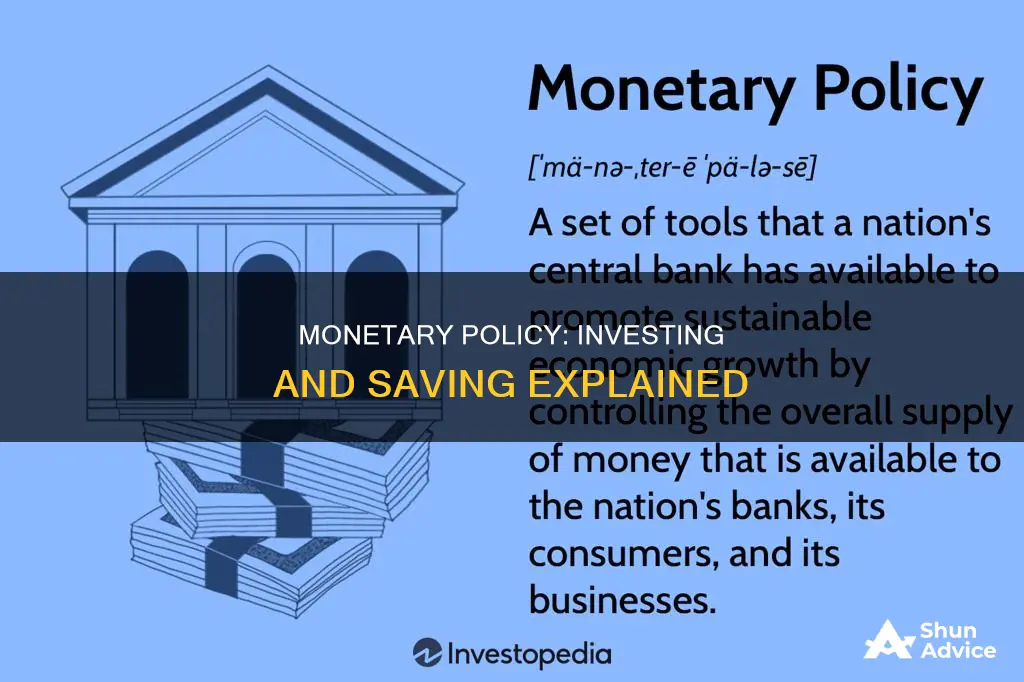
Saving, investing, and monetary policy are all important concepts in personal finance and economics. Saving refers to storing money safely and accessing it when needed, typically in a bank account. It is a low-risk strategy ideal for short-term financial goals and emergency funds. On the other hand, investing involves using money to buy assets like stocks, property, or mutual funds, with the aim of long-term growth. Investing carries the risk of losing money but offers the potential for higher returns. Monetary policy, enacted by central banks like the US Federal Reserve, involves controlling the money supply in an economy to promote growth, control inflation, and maintain stable prices. It uses tools like interest rates and reserve requirements to influence borrowing, spending, and savings rates. Understanding these concepts is crucial for financial security and achieving economic objectives.
What You'll Learn
- Monetary policy tools: interest rates, bank reserves, and open market operations
- Monetary policy goals: maximum employment, stable prices, and moderate interest rates
- What is saving Deferring consumption and storing in an asset?
- What is investment Acquiring an asset or item to generate income or appreciation?
- Types of investments: stocks, bonds, real estate, commodities, and more

Monetary policy tools: interest rates, bank reserves, and open market operations
Monetary policy is a set of tools used by a country's central bank to control the overall money supply and promote economic growth. In the United States, the Federal Reserve Bank is responsible for implementing monetary policy. The Federal Reserve's mandate is to achieve maximum employment while keeping inflation under control.
Monetary policy tools can be classified into three main categories: interest rates, bank reserves, and open market operations.
Interest Rates
The central bank of a country may revise the interest rates it charges to loan money to the nation's banks. As rates rise or fall, financial institutions adjust the rates for their customers, such as businesses or home buyers. Higher interest rates make borrowing more expensive, while lower interest rates encourage borrowing and spending.
Bank Reserves
Bank reserves refer to the amount of cash that banks are required to maintain as reserves. The central bank can revise the amount of cash that banks must hold in reserve, thereby influencing the amount of money available for lending. Lower reserve requirements allow banks to offer more loans, while higher reserve requirements curtail lending and slow down economic growth.
Open Market Operations (OMO)
Open market operations involve the buying and selling of government securities by the central bank. By purchasing securities from banks, the central bank increases the money supply and the banks' reserves, leading to a reduction in interest rates. Conversely, selling securities reduces the money supply and bank reserves, resulting in higher interest rates. Open market operations allow the central bank to control the money supply and influence interest rates.
Condo Conundrum: Save or Invest?
You may want to see also

Monetary policy goals: maximum employment, stable prices, and moderate interest rates
Monetary policy is a strategy employed by central banks to monitor and control the money circulating in an economy. The ultimate goal is to achieve long-term economic growth and stability. In the US, the Federal Reserve (also known as "the Fed") is responsible for implementing monetary policy. The Fed has a “dual mandate” to pursue maximum employment and stable prices, with an additional goal of maintaining moderate long-term interest rates.
Maximum Employment
The Federal Reserve aims to keep unemployment low, ideally in the range of 3.5% to 4.5%. This is done to foster productivity and economic growth without causing excessive inflation. Monetary policies that increase the money supply, such as lowering interest rates, can help reduce unemployment by stimulating business activities and expanding the job market.
Stable Prices
Stable prices refer to maintaining low and steady inflation, generally targeting an average annual price increase of around 2%. This goal is crucial to prevent runaway inflation, which can erode the purchasing power of consumers and disrupt economic stability. Central banks use various tools, such as adjusting interest rates and reserve requirements, to stabilize inflation.
Moderate Interest Rates
Moderate long-term interest rates are crucial for maintaining economic stability. The Fed influences interest rates through various means, including the federal funds rate, open market operations, and the discount rate. During economic downturns, the Fed may lower interest rates to encourage borrowing and spending, stimulating economic growth. Conversely, during periods of high inflation, the Fed may raise interest rates to curb excessive spending and borrowing.
These three goals of maximum employment, stable prices, and moderate interest rates are interconnected and work together to promote a healthy and stable economy. The Federal Reserve uses a range of tools and strategies to achieve these goals and adapt to changing economic circumstances.
Young Savers: Investing for the Future Now
You may want to see also

What is saving? Deferring consumption and storing in an asset
Saving is a concept that means different things to different people. For some, it means putting money in the bank, while for others, it involves buying stocks or contributing to a pension plan. In economics, saving has a specific meaning: consuming less in the present to be able to consume more in the future. Therefore, saving is the decision to defer consumption and store this deferred consumption in an asset.
Saving is often confused with investing, but they are distinct concepts. While most people view the purchase of stocks and bonds as investments, economists use the term "investment" to refer to additions to the real stock of capital, such as plants, factories, and equipment. Saving involves reducing expenditures and can be achieved through various methods, such as deposit accounts, pension accounts, or investment funds. It is important to distinguish between "saving" as an activity and "savings" as the assets in the form of cash.
Monetary policy, on the other hand, is a strategy employed by central banks to manage the money circulating in an economy and achieve long-term economic growth. Central banks may employ contractionary or expansionary measures depending on the economic situation. Contractionary policies are used during periods of high inflation, while expansionary policies are implemented during recessions. These policies impact interest rates, which in turn influence the decisions of households and businesses regarding spending and saving. Lower interest rates, for example, reduce the incentives for households to save and encourage spending.
The transmission of monetary policy is a complex process that flows through to economic activity and inflation. It can be summarised in two stages: changes to monetary policy affect interest rates, which then impact economic activity and inflation. Monetary policy influences economic activity by changing the incentives for saving and investment, affecting consumption, housing investment, and business investment.
Investing Life Savings: Strategies for Long-Term Financial Growth
You may want to see also

What is investment? Acquiring an asset or item to generate income or appreciation
An investment is an asset or item acquired with the goal of generating income or appreciation. Appreciation refers to the increase in the value of an asset over time. In other words, an investment is a strategy to leverage money today for a greater payoff in the future.
Investments can take many forms, including bonds, stocks, real estate, or alternative investments. Bonds, for example, often require an upfront investment and pay recurring interest over time, while stocks represent ownership in a company and may entitle the investor to dividend distributions. Real estate investments involve physical spaces that can be utilised, such as land, office buildings, warehouses, or residential properties.
The primary way to gauge the success of an investment is to calculate the return on investment (ROI). ROI is calculated using the formula:
ROI = (Current Value of Investment - Original Value of Investment) / Original Value of Investment
This allows for the comparison of different investments across various industries.
It is important to note that investments carry a certain level of risk, and this risk is typically correlated with potential returns. Investors must carefully assess their risk tolerance and investment objectives before making any decisions. Diversification is a strategy used to reduce risk by investing in a variety of assets within a portfolio.
Monetary policy, on the other hand, refers to the strategies employed by central banks to control the money supply in an economy and achieve economic growth. These policies can be categorised as either expansionary or contractionary. Expansionary policies are implemented during times of economic slowdown or recession to stimulate growth by lowering interest rates, making saving less attractive, and encouraging consumer spending and business investment. Contractionary policies, on the other hand, are used during periods of robust economic growth or high inflation to slow down the economy by increasing interest rates and making borrowing more expensive.
Monetary policy tools include open market operations, changes to the discount rate (the interest rate charged by central banks to depository institutions on short-term loans), and adjustments to reserve requirements (the proportion of deposits that banks must maintain as reserves). These tools influence interest rates and affect the borrowing, spending, and saving behaviours of individuals and businesses.
Investing While Saving for a Home: Wise or Risky?
You may want to see also

Types of investments: stocks, bonds, real estate, commodities, and more
There are several types of investments that individuals can choose from to build their investment portfolios. Here are some of the most common types of investments:
- Stocks: Stocks, also known as shares or equities, represent ownership stakes in a company. When individuals buy stocks, they become shareholders and have the potential to earn money through capital gains and dividends. Stocks are considered riskier compared to other investments due to their fluctuating value and associated market, commodity price, company, liquidity, and economic risks. However, they offer the potential for higher returns over the long term.
- Bonds: Bonds are debt securities or instruments that allow individuals to lend money to a company or government. In exchange, the borrower pays interest over time. Bonds are used to finance operations, purchases, or projects. They offer a fixed interest rate, providing a steady stream of income for investors. Bonds are generally less volatile and less risky than stocks.
- Real Estate: Real estate refers to land and physical structures such as buildings, homes, apartments, or commercial properties. Individuals can invest in real estate for capital appreciation, rental income, or self-accommodation. It is a reliable and profitable long-term investment but requires significant upfront costs and maintenance. Real estate investments also tend to be illiquid, making them less liquid than stocks or bonds.
- Mutual Funds: Mutual funds are investment vehicles where multiple investors pool their money together to purchase securities such as stocks, bonds, or other assets. These funds are managed by professional fund managers and provide diversification and reduced risk compared to individual stock investments. However, mutual funds may have higher fees and lack control over the investment decisions.
- Exchange-Traded Funds (ETFs): ETFs are similar to mutual funds but trade on a stock exchange throughout the day. They offer diversification, liquidity, and cost-effectiveness. ETFs distribute dividends and can be easily purchased and sold. However, they may have additional trading costs and lower dividend yields compared to individual stocks.
- Commodities: Commodities refer to tangible resources such as gold, silver, crude oil, and agricultural products. Individuals can invest in commodities directly by buying physical commodities or investing in futures, or indirectly by investing in companies that produce them. Commodities are considered a good inflation hedge as their value tends to rise with increasing prices.
- Cryptocurrency: Cryptocurrency is a digital or virtual currency that uses cryptography to secure transactions. It is decentralized and not backed by any central authority, government, or banks. The value of cryptocurrencies, such as Bitcoin, Ethereum, or Dogecoin, is determined by market supply and demand. Cryptocurrencies offer cost-effective transactions and exponential industry growth but are highly volatile and susceptible to scams.
These are just a few examples of the types of investments available. Each investment type has its own characteristics, risks, and potential returns. Individuals should carefully consider their financial goals, risk tolerance, and investment horizon before deciding on the appropriate investment mix for their portfolios.
Savings or Investing: Which Offers Better Liquidity?
You may want to see also
Frequently asked questions
Monetary policy is a set of tools used by a nation's central bank to control the overall money supply and promote economic growth. Strategies include revising interest rates and changing bank reserve requirements.
Monetary policy can affect firms' demand for capital as an input into the production process. This is because interest rates affect decisions on saving or investing and can boost aggregate demand.
Monetary policy can influence economic activity by changing the incentives for saving. Lower interest rates on bank deposits reduce the incentive for households to save.







